- Home
- Susan Wittig Albert
Queen Anne's Lace Page 4
Queen Anne's Lace Read online
Page 4
“Be brave, Annie,” Adam said. He told her as gently as he could and caught her in his arms as she swayed and fell. He carried her to her bed and sent one of the smithy boys for Dr. Grogan, then stayed with her until he arrived. Later, he went to Carter’s Pharmacy for the medicines the doctor prescribed, then waited to see if anything else was needed.
But Annie was in her seventh month, and her husband’s death was more than she could bear. That night, the pains began. She went into early labor and the next morning gave birth to Douglas’ child, a tiny boy who never drew a breath.
Her husband was gone and her baby, as well. Between one day and the next, within just twenty-four short hours, Annie’s life was utterly changed.
* * *
• • •
TIME heals all wounds, people said. But people were wrong.
Three years later, Annie was still learning to live in Douglas’ absence: to sleep in an empty bed and eat at the table by herself and try to imagine a future alone. She often remembered what Gramma Anne had told her when she was learning to make bobbin lace. Still a young girl, Annie would lean against her grandmother’s chair, watching the gnarled hands pick up first this bobbin, then that, weaving them under and over, over and under, so quickly that Annie’s eyes could scarcely follow.
“Magic,” Annie whispered, as the pattern of tiny flowers and birds appeared, mysteriously, in the lace. “Gramma, it’s magic!”
Her grandmother’s smile lifted the corner of her mouth as her hands continued to move. “Well, yes, it’s a little bit of magic. But more, it’s paying attention. And understanding the pattern so well that your fingers know what to do before your mind can tell them.” Her swiftly moving hands stopped, reversed the last two overs-and-unders, and did them again, the right way. She gave Annie a serious look. “And catching the little accidents before they get to be big ones. Sometimes you can work the mishaps into the pattern and make something new.”
After Douglas’ death, Annie often thought of her grandmother’s words. Sometimes you can work the mishaps into the pattern and make something new. It could be a rule of life, too. But like any rule, it was easy to put into words and harder to put into practice. What could be the pattern of a life that seemed to promise so much—a caring husband, a baby son—and then be so suddenly, so tragically altered?
Sometimes, when her grief was the sharpest, Annie would take down the wooden casket with the flower carved on the lid. The flower was Queen Anne’s lace and the casket was walnut, Gramma had said, made by her father—Annie’s great-grandfather—in Massachusetts, just after the Revolutionary War. Annie kept the casket on the tall pine chest of drawers in her bedroom. It held Gramma Anne’s collection of treasured pieces of laces, some of them brought from the Old Country. When she felt terribly sad, Annie would open the casket and take out the pieces one by one, appreciating the techniques and the expert workmanship, admiring the intricate patterns, loving each one because it had belonged to her grandmother.
But most of all, Annie loved the laces because each of them told a story—a woman’s story. There was the fine, intricately embroidered net veil that Gramma’s mother had made to wear as a bride. The crocheted lace for the nightgown she wore on her wedding night and gave to her daughter. Gramma’s best lace cap. The delicate collar and cuffs that Annie’s mother had crocheted. The tiny cap Annie had made for the baby she had lost, the ivory lace as fine as cobwebs. Gramma had often said that the experiences of a woman’s life—hope and joy and love, pain and despair and grief—were stitched and woven and twisted and knotted into the lace she made and wore, and that those feelings lingered there like a faint perfume. The fragile ghosts could sometimes be felt much later, she said, by the right wearer, under the right conditions. Annie understood that, for she could no longer bear to wear the jet-black collar and cuffs she had made for her best dress during the year after Douglas died. Just a touch of the lacy whorls and black-beaded florets, and she was almost overwhelmed by the grief that had drowned her the whole of that year.
And life itself was like a lace, Annie thought as she turned the pieces over in her fingers, looking at the patterns, holding them up to the light. Lace was a delicate pattern of threads and spaces, sometimes familiar and expected, sometimes surprising. Life was a fragile weaving of words and actions and intentions around the absences that love—and hope and imagination—could fill with a magical promise for the future.
But in her life now, those spaces were merely empty, or filled with the sadness of loss and the ache of unfulfilled desire. Her husband and her infant son were lost to her forever.
Absence and emptiness. Unfilled spaces. Unfulfilled dreams.
* * *
• • •
WHEN most of a year had gone since Douglas’ death, Annie had recovered enough to acknowledge that if she didn’t take responsibility for putting her life in order, nobody else would. Empty and bleak as the future seemed, she had to face it, alone.
Annie was fortunate that the house Douglas built for her had no mortgage. But there was not a penny coming in and after some months her small savings were depleted. She let her maid go and began doing the housework and cooking—what little there was of it—herself. She got three leghorn hens and a rooster from a neighbor across the street and began her own flock of chickens, so she would have fresh eggs every day. She planted a vegetable garden outside the back door, where greens and peas and carrots and onions would be handy for the pot. And Tobias Sharp, one of Douglas’ helpers, took over the blacksmith business, paying a small rent for the smithy and a commission on its earnings.
But it was her next-door neighbor, Adam, who did the most to help her get through the year after Douglas died. Adam owned the tack and feed store between Purley’s General Store and the railroad tracks. He leased Douglas’ stable for his horses and generously offered to do the little household repairs Annie would otherwise have had to pay for—over (she was sure) the objections of his wife, Delia.
Ah, Adam. After half a year or so, Annie understood that her feelings about him had changed. When Douglas was alive, he had been her husband’s friend and a frequent visitor, and she had smiled at the sounds of men’s voices and laughter in her kitchen. Now, despite her best intentions, she had fallen into the habit of listening eagerly for Adam’s step outside the kitchen door. His presence seemed to fill the room, his voice made her shiver, and she was all too deeply aware of the male scent of sweat and tobacco. She tried to discipline herself against her heightened anticipation of his coming, but it wasn’t easy.
“Please let me know if there’s anything more I can do to help,” he would say when he had finished the little chores she thought up for him. He didn’t add, Douglas would want me to do this, but she knew that was why he came so often. She felt deeply grateful, but soon, she felt more, and she had to acknowledge the unsettling truth: she wished that Adam’s visits were something more than ordinary kindness toward the widow of his best friend. This was not a truth she welcomed, for with it came an uneasy guilt.
Still, those moments were among the brightest in her week, and as she fell asleep at night, Annie often found herself thinking of the hint of laughter hiding in the corners of Adam’s mouth, the gentle regard in his brown eyes, the attentive way he watched her, listening as she talked about her plans. Annie knew how dangerous it was to indulge in these imaginings, and often chided herself. Adam was a married man with a wife and a dear little girl and—while she might wish to read something different into his glances or his tone of voice—his attentions toward her were always entirely proper. Her feelings (she told herself) were simply the natural result of her loss and her desperate loneliness. As long as she kept them to herself, kept herself under control, and behaved as properly as he, there could be no harm.
When Annie recovered enough to make plans for her future, she turned to the lace that had once been a pleasing way to spend her idle hours. Now, it became
something more important: a way to earn her livelihood. Her financial situation was still precarious, but with the income from the stable and the smithy and what she might earn from the lace, there could be just enough.
Before Douglas died, Annie had sold her best lacework only to friends. Now, as soon as she felt well enough, she put on her best dress and jacket, boarded the train to Austin, and—carrying samples of her work—visited Austin’s two women’s shops: Madame LaMode’s Millinery on Pecan Street and Mrs. Turner’s Ladies’ Exclusive Dress Shoppe on Congress Avenue, just two blocks south of the new capitol building. She was surprised and delighted when both Mrs. Turner and Madame LaMode (whose real name was Gertrude Winkle) approved of her work and told her they would sell everything she could produce, at prices that surprised her. Lace, it seemed, was all the rage these days. Ladies were mad for lace parasols, lace-trimmed camisoles and chemises and negligees, lace gloves, veils, handkerchiefs, collars, lace on bodices and blouses, lace lavished on beautiful hats. Cheap lace was manufactured by machines so every woman could have a bit of lace at her throat and wrists, but the discriminating eye could easily see the difference between machine-made and handcrafted lace. The fashionable women of Austin were discriminating—and wealthy enough to pay the prices the shops thought fair.
When Annie realized that her lace business might actually turn into a paying enterprise, she gave it a name—Annie’s Laces—and had some calling cards printed up. The cards had scalloped, lacelike edges, her name and address, and a pastel drawing of Gramma Anne’s favorite flower, Queen Anne’s lace. Within the month, she had more work than she could manage alone, so she hired a helper. When she needed more, an advertisement in the Pecan Springs Weekly Enterprise brought her girls who were already skilled with a needle and were glad to earn some extra money without going out to work as domestics. Soon she was employing half a dozen, all working on a generous commission.
Annie’s girls worked in the large sitting room at the front of the house, in comfortable chairs arranged where the sunlight gave them plenty of natural light for their lacemaking, with baskets beside their chairs to hold their thread, scissors, and other supplies. As they worked, they chatted and gossiped and often sang. In the winter and spring, they had read aloud from Louisa May Alcott’s Little Women, the touching story of the four March sisters, Meg, Jo, Beth, and Amy. When Beth died so bravely—Annie herself had read that day, in a faltering voice—they all wept. This summer, they were reading Mark Twain’s new novel, Adventures of Huckleberry Finn. Annie didn’t think there would be any tears for that story.
The “girls” weren’t all girls, of course. Opal and Ida Jean were the youngest, giggly twins at seventeen but skilled and quick with their crochet hooks and knitting needles. Mrs. Caldwell and Miss Windsor, both steady workers in Irish lace, were in their forties. Old Mrs. Hathaway came from across town and her niece, Mrs. Hannah Jenson, from Travis Street, the next block over. Both Mrs. Hathaway and Mrs. Jenson were bobbin lace makers, good ones, too, and every bit as adept and as fast as Gramma Anne. Annie herself made both gros point lace and embroidered net, which was in great demand.
Adam’s wife, Delia, occasionally came from next door to join them in the workroom, but she wasn’t as skilled, nor as interested, as the others. Golden-haired, with a delicate, heart-shaped face, Delia reminded Annie of the petted and spoiled Amy March. She hadn’t the patience to pay attention to what her fingers were doing, so her crocheted laces were loose and clumsy. She was quick to criticize others’ work and replied sharply when anyone offered her suggestions for improving her own—which she had no need to sell, so she couldn’t be bothered to make it better. Annie couldn’t imagine why Delia joined them.
Although Annie’s conscience might prick her for her disturbing midnight imaginings about Delia’s husband, she knew she had given her neighbor no reason to be jealous. But she was finding it increasingly difficult to manage the envy that flared up like an unbanked fire whenever she was in Delia’s company. Her neighbor had everything any woman might want: a generous and attractive husband, a lovely child, a comfortable house, and a hired girl to cook the meals and do the housework. Delia’s little daughter, sweet six-year-old Caroline, sometimes came to Annie’s house to make lace. Annie, who believed that all children were by nature highly creative, was teaching her how to crochet, and her small fingers were already much more adept than her mother’s. She had made a crocheted cover for Delia’s pincushion and was working on a doily for her dressing table. Annie loved little Caroline and envied Delia the daily delights the child must bring.
But Delia seemed to care little for these blessings, and she often indulged in a litany of complaints. At the top of her list: the hired girl, Greta, who was insolent and had to be continually reprimanded (which Annie already knew, because she frequently heard Delia shrieking at the poor thing). Village life was boring and Delia wished Adam would buy a store in Austin, so they could move to the capital city. Or if not Austin, then to Galveston, where she had grown up and which she visited at every opportunity. She even complained about her husband, who (she said) rarely took her anywhere and was stingy when it came to new clothes and especially jewelry.
“Every girl likes a shiny bauble now and then,” Delia would say, and sigh that she had none—although almost every time Annie saw her, she had something new. Pink mitts, to match a new dress, or a new hat or a pretty broach.
Annie thought her pretty neighbor was one of the most fortunate women on earth and simply could not understand her complaints. This was especially true when Delia confided that Adam thought they ought to have a second child.
“But I never intended to have more than one,” she had added hastily. “Babies ruin your figure. And they take up so much of your time.”
As Delia spoke, Annie thought of Adam, so generous and strong and yet gentle, and a sudden bitter longing swept through her. How could Delia refuse him? If Adam were her husband, she would welcome his child, his children—as many as the Good Lord cared to send them.
But that thought took her to another thought, and to a dark place that she could enter only in her dreams. Annie pushed it away.
Chapter Three
Queen Anne’s lace or wild carrot (Daucus carota) is the foremother of those pretty deep-orange carrots (Daucus carota sativus) you’re planning to cook for supper tonight. The plant first emerged in what is now Afghanistan and Iran and has traveled around the globe. Its long, spindle-shaped root is ivory or yellowish. And edible, but only when young, because the inner core becomes fibrous and woody as the plant grows.
After the potato, the modern carrot is the second most popular vegetable in the world. And it’s not just orange! If you’re looking for a way to entice your kids to eat more veggies, surprise them with a helping of purple (or red, yellow, or white) carrots. Whatever the color, this special vegetable is loaded with nutritious beta-carotene and a wide variety of antioxidants and other health-supporting nutrients.
“Anne’s Flower”
China Bayles
Pecan Springs Enterprise
“Hey, Mom!” Caitie threw her backpack into the backseat of my old white Toyota and slid in beside me. She was wearing green shorts and a bright orange tee that said Kids Act Up!
Caitie’s casual greeting made my heart flip, as it always does. She has been a member of our family for three years now, but it was a long while before she could call me Mom. The word is still new and wonderful for me, too. As a young career woman with an all-consuming job, I’d put motherhood fairly far down on my agenda. And yet, here now is this miracle of a girl-child. I consider myself one of the luckiest women on earth.
“Hey, Cait.” I patted her bare knee. “How was rehearsal?”
“It was great! I died today.” She giggled. “I got to die twice.”
“I hope you died well.” I shifted into gear and pulled away from the curb. “Bravely, I mean. Without a lot of fuss.”
“Oh, I did. Both times.” Another giggle. “Everybody cried.”
A half dozen years ago, a couple of drama professors from CTSU got a grant to restore the old International and Great Northern railroad depot on Sam Houston Street for use as a community theater. It was a brilliant idea, since otherwise, the I&GN depot would have been razed and a big chunk of Pecan Springs’ history lost. Caitie is playing Beth in Little Women, the Depot’s Summer Kids Theater production. The director says she’s doing a fine job.
That’s no surprise to me. Last summer, the kids put on Peter Pan. Caitie played Peter to thunderous applause, especially when she flew across the stage. She was a natural fit for the role. She’s small for her age, slender and pixielike, with short dark hair, large dark eyes, and a marvelously expressive face. I often wish her parents could see her now and share my pride in their daughter’s energy and courage. Miles, her father and my half brother, didn’t come into my life until we were both adults, and he was killed before I had a chance to know him very well. I never knew her mother, either, who drowned in a boating accident when Caitie was very young. Their daughter is now ours, McQuaid’s and mine. Our daughter, and very, very dear.
Caitie blew out her breath. “The only thing I don’t like about the play is the costumes. They’re so pretty, with all that frilly lace and ribbons. But the long skirt keeps tangling around my legs and tripping me up. I don’t see how Beth could run in it, even if she wasn’t sick a lot of the time.”
“I don’t think girls did much running in those days,” I remarked, signaling for a left turn.
“Except for Jo,” Caitie reminded me. “Jo was a tomboy. I wish they’d cast me to play her.” She paused, looking down at her bare knees. “I’ll bet girls had to wear those skirts to keep them from running,” she said thoughtfully. “And to hide their legs. Back in those days, people weren’t supposed to see anybody’s legs.”

 Hemlock
Hemlock Chile Death
Chile Death The Tale of Briar Bank
The Tale of Briar Bank Widow's Tears
Widow's Tears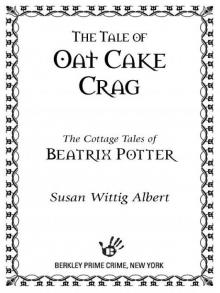 The Tale of Oat Cake Crag
The Tale of Oat Cake Crag Rueful Death
Rueful Death Bittersweet
Bittersweet The Darling Dahlias and the Poinsettia Puzzle
The Darling Dahlias and the Poinsettia Puzzle A Wilder Rose: A Novel
A Wilder Rose: A Novel Spanish Dagger
Spanish Dagger The Darling Dahlias and the Texas Star
The Darling Dahlias and the Texas Star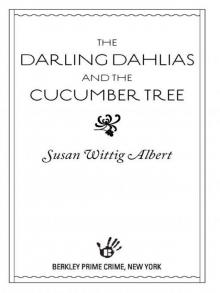 The Darling Dahlias and the Cucumber Tree
The Darling Dahlias and the Cucumber Tree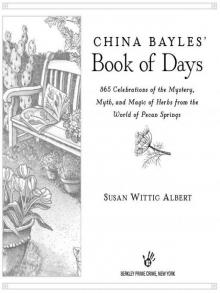 China Bayles' Book of Days
China Bayles' Book of Days Death Come Quickly
Death Come Quickly Blood Orange: A China Bayles Mystery
Blood Orange: A China Bayles Mystery Cat's Claw
Cat's Claw The Darling Dahlias and the Naked Ladies
The Darling Dahlias and the Naked Ladies The Tale of Hill Top Farm
The Tale of Hill Top Farm The Darling Dahlias and the Confederate Rose
The Darling Dahlias and the Confederate Rose The Darling Dahlias and the Silver Dollar Bush
The Darling Dahlias and the Silver Dollar Bush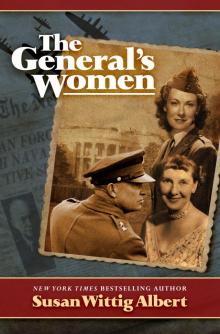 The General's Women
The General's Women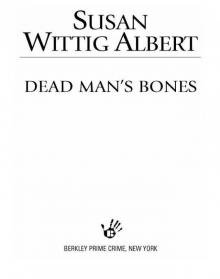 Dead Man's Bones
Dead Man's Bones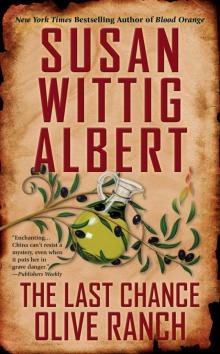 The Last Chance Olive Ranch
The Last Chance Olive Ranch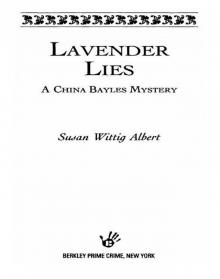 Lavender Lies
Lavender Lies The Tale of Hawthorn House
The Tale of Hawthorn House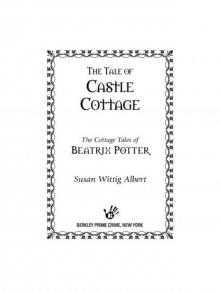 The Tale of Castle Cottage
The Tale of Castle Cottage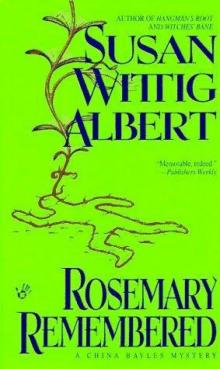 Rosemary Remembered - China Bayles 04
Rosemary Remembered - China Bayles 04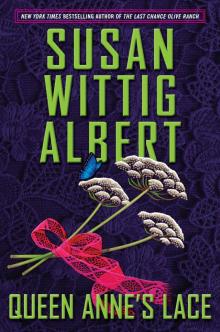 Queen Anne's Lace
Queen Anne's Lace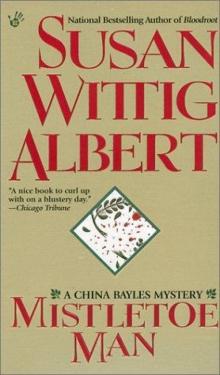 Mistletoe Man - China Bayles 09
Mistletoe Man - China Bayles 09 The Darling Dahlias and the Unlucky Clover
The Darling Dahlias and the Unlucky Clover Mourning Gloria
Mourning Gloria The Darling Dahlias and the Eleven O'Clock Lady
The Darling Dahlias and the Eleven O'Clock Lady